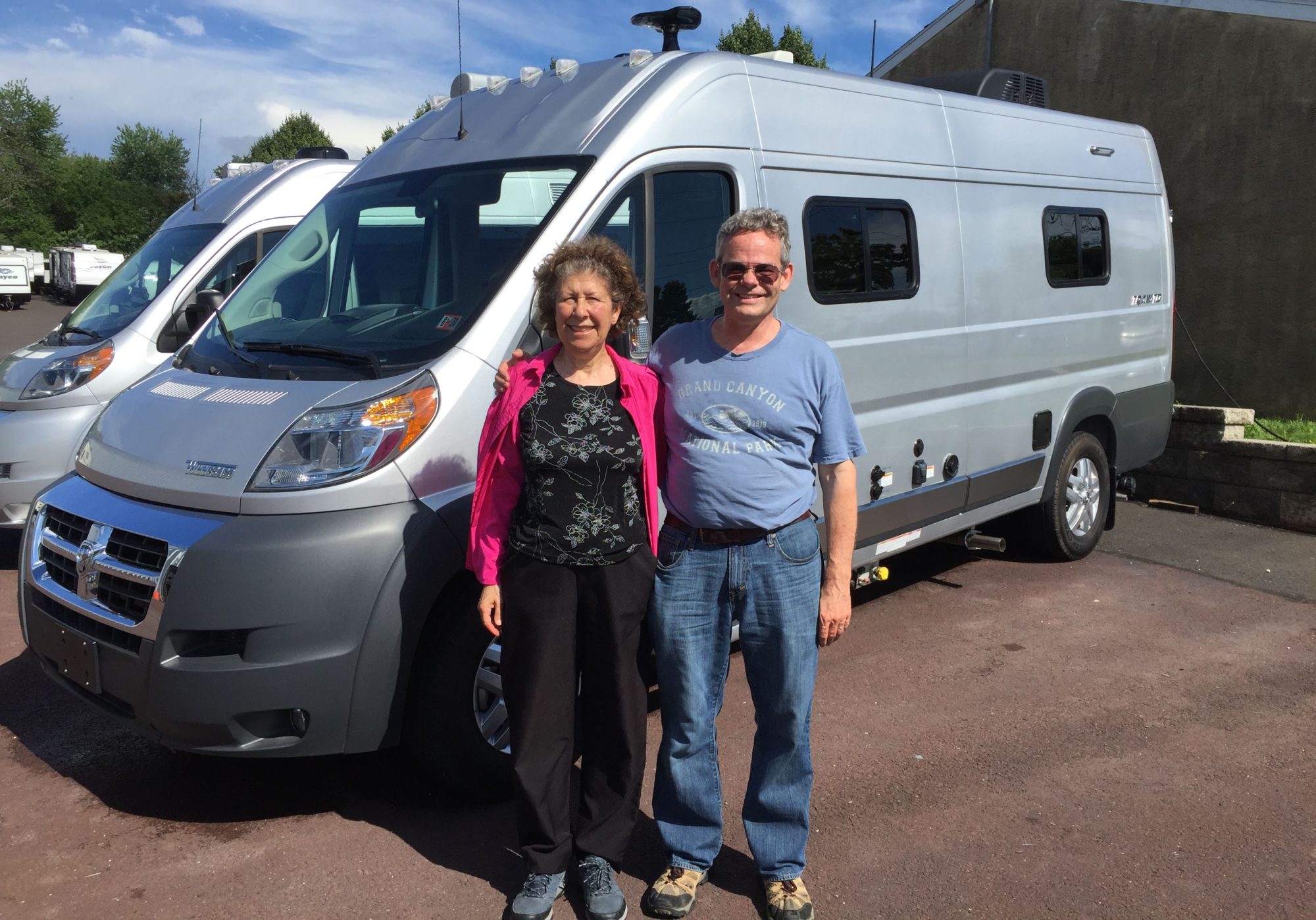Indianapolis (Oct 21)
Our RV park hostess is the very bubbly daughter of the owners. She was a hairdresser, and had decided to move to NYC when her parents requested help running the campground. She says she loves it and is glad that she stayed home. She certainly seems happy, despite long working days.
After the long drive, Chuck needed a rest day. There were 3 craft stores near the RV park and I visited all of them over a 2 day period trying to find yarn for Elisabeth’s poncho. The criterion for yarn are that I do not want it to be entirely synthetic but it has to be soft and not scratchy. As well, the thickness has to be appropriate for the pattern that Elisabeth picked out. Finally, there is color. Of these, yarn thickness proved to be the most difficult – the type of yarn required is not that popular in craft stores. I finally found some 100% wool which is soft and a great color, although it might require some minor pattern adjustments. But the store did not have enough for the entire sweater.
Yarn comes in “dye lots”. Even with modern dyes, using 2 different dye lots for the same item risks having 2 colors in the finished garment – which may not be apparent until the first washing. (This is less problematic for some synthetic yarns, but for wool it remains a problem.) So, I now have to find a store that has enough of this color yarn to make the entire sweater. As I have learned since, craft stores do not carry yarn in quantities large enough to make a sweater. Alternatively, I can order on the internet, but it is not so clear where to make the delivery.
We planned to do a Segway tour of Indianapolis, but the rainy weather on Monday nipped that plan in the bud. Instead, we drove to downtown Indianapolis and walked around.
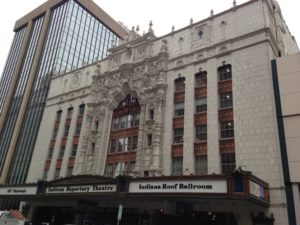
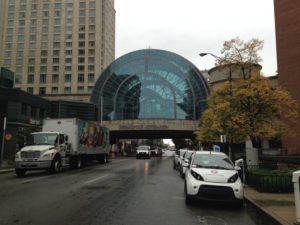
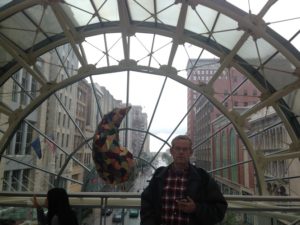 The internet does not have a lot of suggestions of what to do in Indianapolis, but we found downtown very nice. It has 2 main shopping and dining streets and plenty of interesting architecture including the older theater above, and, on the same street, this bridge over the intersection which leads to office buildings and a large indoor shopping mall.
The internet does not have a lot of suggestions of what to do in Indianapolis, but we found downtown very nice. It has 2 main shopping and dining streets and plenty of interesting architecture including the older theater above, and, on the same street, this bridge over the intersection which leads to office buildings and a large indoor shopping mall.
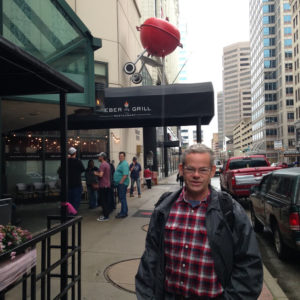 We decided to have lunch at the Weber Grill, where the food is prepared on – yup – Weber grills like the one over Chuck’s head. This is part of a small upscale chain that was started by the Weber-Stevens company that makes the grills. At some point, the family sold the grill manufacturing part, but kept the restaurant chain. (Isn’t it great what you can learn from Wikipedia!). Tempted as I was to try their “beer can chicken” (my favorite thing to make on my Weber) we settled for meatloaf (Chuck), chili and an appetizer sampler (me). The food was very good.
We decided to have lunch at the Weber Grill, where the food is prepared on – yup – Weber grills like the one over Chuck’s head. This is part of a small upscale chain that was started by the Weber-Stevens company that makes the grills. At some point, the family sold the grill manufacturing part, but kept the restaurant chain. (Isn’t it great what you can learn from Wikipedia!). Tempted as I was to try their “beer can chicken” (my favorite thing to make on my Weber) we settled for meatloaf (Chuck), chili and an appetizer sampler (me). The food was very good.
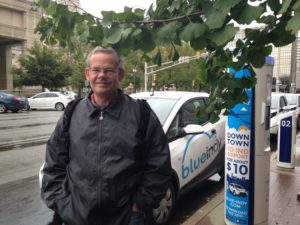 We were also impressed by the fleet of electric cars which are available like Zip cars at several locations.
We were also impressed by the fleet of electric cars which are available like Zip cars at several locations.
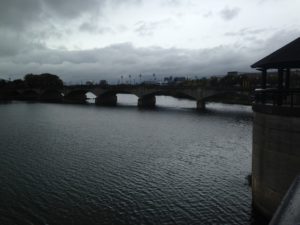 After walking around downtown for a bit, we walked to the White River, which is a tributary of the Wabash that runs through town.
After walking around downtown for a bit, we walked to the White River, which is a tributary of the Wabash that runs through town.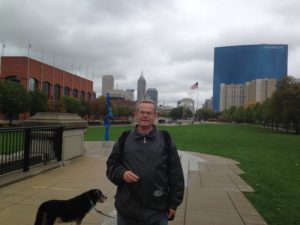 There is a very nice park and a sculpture walk. As well, parts of the U. Indiana and Purdue shared campus facilities border the park, along with the NCAA headquarters. Despite the rain, this was a pleasant walk.
There is a very nice park and a sculpture walk. As well, parts of the U. Indiana and Purdue shared campus facilities border the park, along with the NCAA headquarters. Despite the rain, this was a pleasant walk.
The walk took us past the Indiana History Museum and the Eiteljorn Native American and Western Art Museum. Chuck decided to visit the former while I went to the latter. Both museums had the sad history of the eviction of the native peoples through population pressure, broken treaties and disease. The Miami Indians had generously resettled the tribes who had been displaced from further east, but this did not save them from being forced out of their lands later.
One ironic incident occurred when a wily chief convinced his village to adopt European agriculture and Catholicisim. They were the only group not forcibly removed. However, in the early 1900’s they lost their status as “Native people” and with it the benefits that this now gives in terms of laws and taxes. It took decades to re-establish their status.
The Eiteljorn Museum has 3 sections, of which I saw two. The ground floor is devoted to western American art, which is primarily paintings and bronzes by people of European original about western landscapes and life among the native Americans and cowboys. (A lot of the latter were based on brief visits, Wild Bill Cody shows or romanticized accounts.) There is a particularly impressive triptych of the Grand Canyon by Hurley which is on a suitable grand scale and definitely captures the feel of the place. It can be viewed here: https://westernartandarchitecture.com/Features/Story/the-eitejorg-museum.
The ground floor also has a fine collection of Remington paintings and bronzes, included an “unauthorized” casting of his first bronze which is available for touching. I was amazed to find that the stirrups actually swing free. As well, there were a number of similar paintings and bronzes by others, less well-known artists, which show that Remington did not work in a vacuum. I really liked many of the paintings.
Upstairs there is a gallery of modern work by native American artists, which I did not have time to see, and a gallery of historic and “traditional style” work also by native American artists. Actually, it is hard to determine where the line should be drawn, as much of the fine sculpting beadwork, basketry, weaving and masks and other “tradtional” crafts were made for the tourist market and are pretty recent.
The exhibit was done, as is common, by geographic region, and included some art types I had not seen before. It deliberately blurred the lines of what is “traditional” by mixing historic pieces with modern works in traditional style.
The Arctic exhibit included many very interesting works made from whale vertebrae. The material is quite interesting, being very porous. But besides that , several of the artists had used the shape of the vertebrae to shape their work, which was a very interesting use of the material.
I was quite interested also in the description of why native communities have been allowed to continue hunting endangered whales in the interests of preserving traditional customs. When I worked with the whale acoustics research group at Cornell, their viewpoint was less sanguine. In 1999 the Makah tribe killed a gray whale as part of a restoration of aboriginal rights. However, traditional skills in butchering the kills had been lost, so that the carcass of the whale, instead of yielding meat, oil and useful materials was literally putrefying on the beach. Aboriginal whaling remains controversial.
Besides the whale bone objects, there were the more usual objects from stone and walrus ivory and stone prints. These “traditional” items really started to be produced for the tourist trade and became popular in the 1940s, with the development of the Canadian art scene spurred by the Group of Seven. I was amazed to learn that up to 22% of the Cape Dorset community is engaged in art. This must be a considerable percentage of the working age population.
The mix of older and very modern craftsmanship was particularly notable in the southwest pottery section. There are some beautiful modern pieces using traditional shapes and colors.
Another section that was very good was the basketry. This was pretty similar to other collections I have seen. Nevertheless, the craftsmanship on the miniature baskets was superb. It is hard to see how adult hands could make such tiny coils and stitchery.
After the museums closed, we returned to the RV for dinner.
